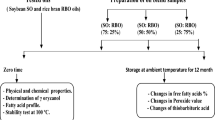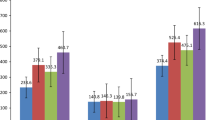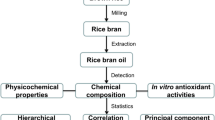Abstract
The compositions of rice bran oils (RBO) and three commercial vegetable oils were investigated. For refined groundnut oil, refined sunflower oil, and refined safflower oil, color values were 1.5–2.0 Lovibond units, unsaponifiable matter contents were 0.15–1.40%, tocopherol contents were 30–60 mg%, and FFA levels were 0.05–0.10%, whereas refined RBO samples showed higher values of 7.6–15.5 Lovibond units for color, 2.5–3.2% for unsaponifiable matter, 48–70 mg% for tocopherols content, and 0.14–0.55% for FFA levels. Of the four oils, only RBO contained oryzanol, ranging from 0.14 to 1.39%. Highoryzanol RBO also showed higher FFA values compared with the other vegetable oils studied. The analyses of FA and glyceride compositions showed higher palmitic, oleic, and linoleic acid contents than reported values in some cases and higher partial glycerides content in RBO than the commonly used vegetable oils. Consequently, the TG level was 79.9–92% in RBO whereas it was >95% in the other oils studied. Thus, refined RBO showed higher FFA values, variable oryzanol contents, and higher partial acylglycerol contents than commercial vegetable oils having lower FFA values and higher TG levels. The higher oryzanol levels in RBO may contribute to the higher FFA values in this oil.
Similar content being viewed by others
References
Gopalakrishna, A.G., Nutritional Components of Rice Bran Oil in Relation to Processing, Lipid Technol. 14:80–84 (2002).
Gopalakrishna, A.G., S. Khatoon, P.M. Shiela, C.V. Sarmandal, T.N. Indira, and A. Mishra, Effect of Refining of Crude Rice Bran Oil on the Retention of Oryzanol in the Refined Oil, J. Am. Oil Chem. Soc. 78:127–131 (2001).
Indian Standards Institution Specification for Rice Bran Oil, IS:3448, Indian Standards Institution, New Delhi, 1984.
The Prevention of Food Adulteration Act 1954, Confederation of Indian Industries, 9 CII, New Delhi 110 003.
Gingras, L., Refining of Rice Bran Oil, inform 11:1196–1203 (2000).
Takeshita, Y., and O. Osamu, An Improved Method for the Acid Value of Rice Bran Oil and Its Identification, Trans. Kokushikan Univ. Dept. Eng.: No. 14 (1981).
AOCS, Official Methods and Recommended Practices of the American Oil Chemists' Society, 4th edn., edited by D. Firestone, AOCS Press, Champaign, 1993.
Anonymous, The Determination of Tocopherols in Oils, Food and Feeding Stuffs in Analytical Methods Committee, Report Prepared by the Vitamin E Panel, Analyst (London), 84:348–371 (1959).
Foglia, T.A., K. Petruso, and S.H. Feairheller, Enzymatic Interesterification of Tallow-Sunflower Oil Mixtures, J. Am. Oil Chem. Soc. 70:281–285 (1993).
Gunstone, F.D., J.L. Harwood, and F.B. Padley (eds.), The Lipid Handbook, Chapman & Hall, London, 1986.
Gopala Krishna, A.G., S. Khatoon, and R. Babylatha Frying Performance of Rice Bran Oils, J. Food Lipids, 12:1–11 (2005).
Author information
Authors and Affiliations
Corresponding author
About this article
Cite this article
Gopala Krishna, A.G., Hemakumar, K.H. & Khatoon, S. Study on the composition of rice bran oil and its higher free fatty acids value. J Amer Oil Chem Soc 83, 117–120 (2006). https://doi.org/10.1007/s11746-006-1183-1
Received:
Accepted:
Issue Date:
DOI: https://doi.org/10.1007/s11746-006-1183-1




